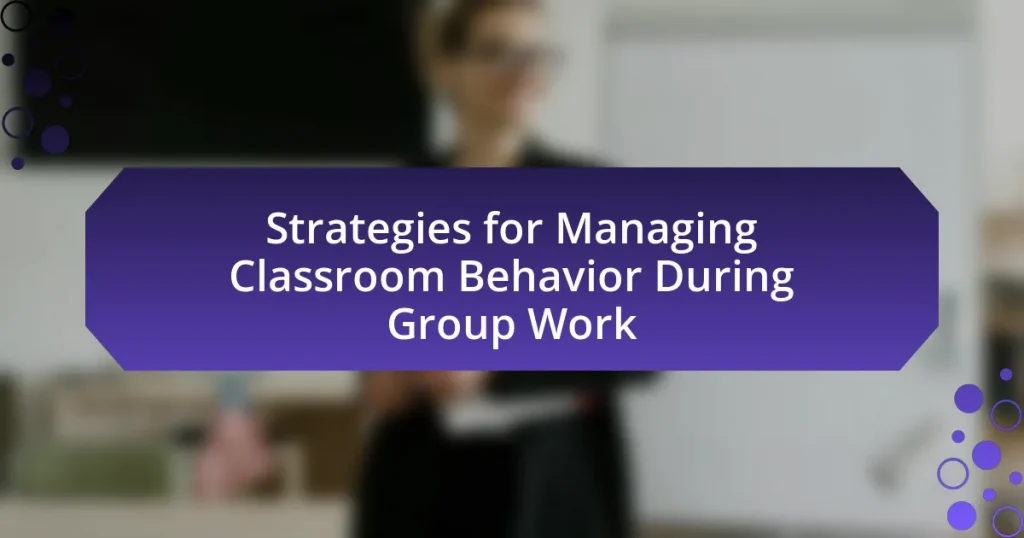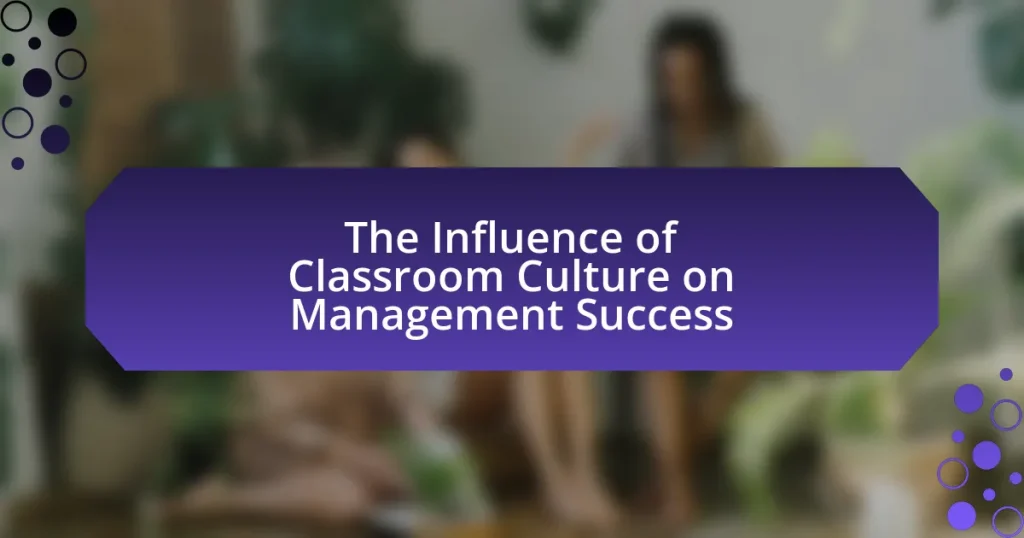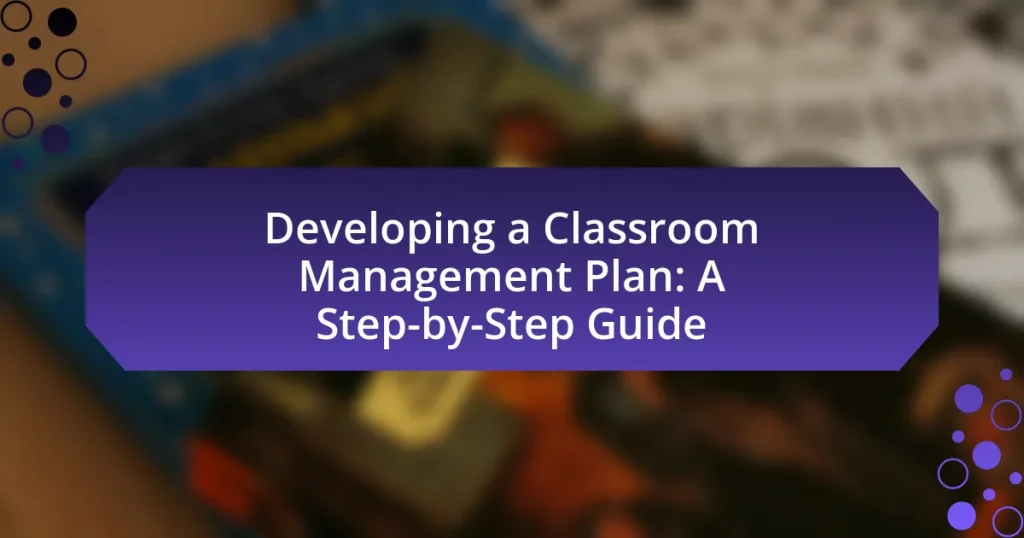Restorative practices in classroom management are strategies designed to enhance school climate by promoting accountability, repairing harm, and fostering relationships among students and teachers. This article outlines the differences between restorative practices and traditional discipline methods, emphasizing the importance of dialogue and understanding over punishment. Key principles such as building relationships, fostering accountability, and promoting healing are discussed, along with their impact on student behavior and social-emotional learning. The article also provides practical steps for educators to implement restorative practices, address challenges, and sustain these approaches in the long term, supported by research indicating significant improvements in student engagement and reductions in disciplinary incidents.
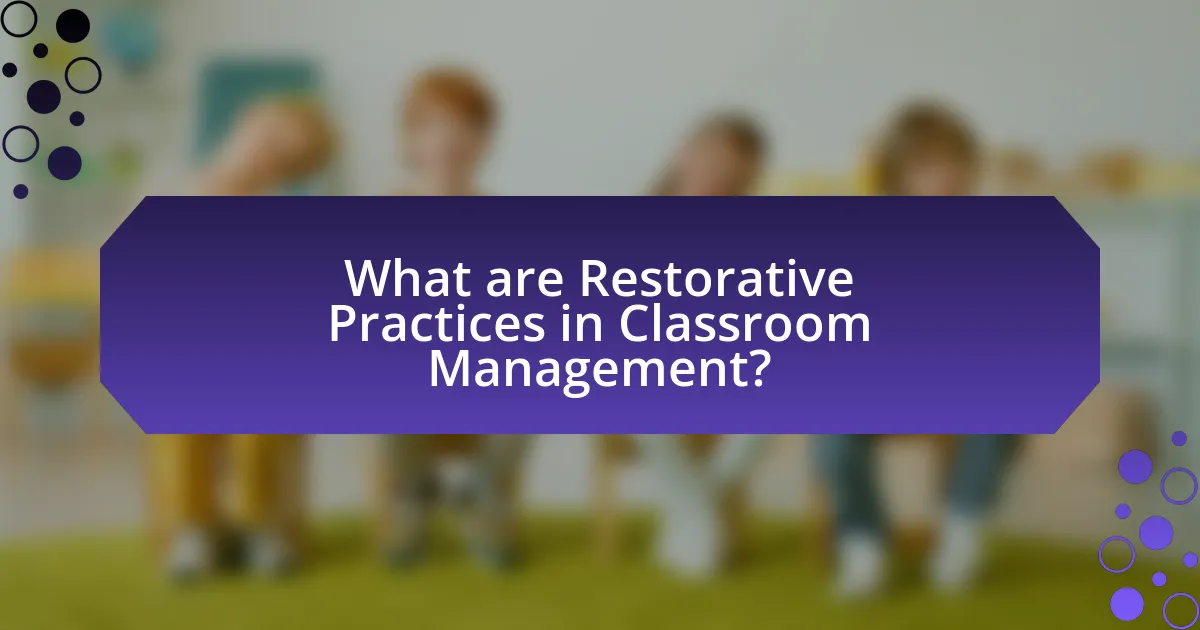
What are Restorative Practices in Classroom Management?
Restorative practices in classroom management are strategies aimed at fostering a positive school climate by promoting accountability, repairing harm, and building relationships among students and teachers. These practices focus on addressing behavioral issues through dialogue and understanding rather than punishment, encouraging students to take responsibility for their actions and understand the impact of their behavior on others. Research indicates that implementing restorative practices can lead to reduced disciplinary incidents and improved student engagement, as evidenced by a study published in the Journal of School Psychology, which found that schools utilizing restorative approaches saw a 50% decrease in suspensions over a three-year period.
How do Restorative Practices differ from traditional discipline methods?
Restorative Practices focus on repairing harm and restoring relationships, while traditional discipline methods often emphasize punishment and control. Traditional methods typically involve a top-down approach where authority figures impose consequences, which can lead to resentment and disengagement. In contrast, Restorative Practices encourage dialogue and understanding among all parties involved, fostering accountability and empathy. Research indicates that schools implementing Restorative Practices report reduced recidivism rates and improved school climate, demonstrating their effectiveness in promoting positive behavior and community.
What are the key principles of Restorative Practices?
The key principles of Restorative Practices include building relationships, fostering accountability, and promoting healing. Building relationships emphasizes the importance of creating a supportive community where individuals feel valued and connected. Fostering accountability involves encouraging individuals to take responsibility for their actions and understand the impact of their behavior on others. Promoting healing focuses on addressing harm and restoring relationships rather than simply punishing wrongdoing. These principles are supported by research indicating that restorative approaches can lead to improved social-emotional outcomes and reduced behavioral issues in educational settings.
How do Restorative Practices promote a positive classroom environment?
Restorative Practices promote a positive classroom environment by fostering a culture of respect, accountability, and community among students. These practices encourage open communication and conflict resolution, allowing students to express their feelings and perspectives, which enhances relationships and reduces behavioral issues. Research indicates that schools implementing restorative practices report a decrease in suspensions and an increase in student engagement, demonstrating the effectiveness of these approaches in creating a supportive learning atmosphere. For example, a study by the International Institute for Restorative Practices found that schools using restorative methods experienced a 50% reduction in disciplinary incidents, highlighting the impact of these practices on classroom dynamics.
Why are Restorative Practices important in education?
Restorative Practices are important in education because they foster a positive school climate and enhance student relationships. These practices focus on repairing harm and restoring relationships rather than solely punishing misbehavior, which leads to improved student engagement and academic performance. Research indicates that schools implementing restorative practices experience a reduction in disciplinary incidents and an increase in student attendance, as evidenced by a study conducted by the International Institute for Restorative Practices, which found that schools using these methods reported a 50% decrease in suspensions. This approach not only addresses behavioral issues but also promotes social-emotional learning, equipping students with essential conflict resolution skills.
What impact do Restorative Practices have on student behavior?
Restorative Practices significantly improve student behavior by fostering a sense of accountability and community. These practices encourage students to reflect on their actions and understand the impact of their behavior on others, leading to reduced incidents of misconduct. Research conducted by the International Institute for Restorative Practices indicates that schools implementing restorative approaches experience a decrease in suspensions and expulsions, with some reporting up to a 50% reduction in disciplinary actions. This evidence supports the effectiveness of Restorative Practices in promoting positive behavior and enhancing the overall school climate.
How do Restorative Practices support social-emotional learning?
Restorative Practices support social-emotional learning by fostering a sense of community, accountability, and empathy among students. These practices encourage open dialogue and reflection, allowing students to express their feelings and understand the impact of their actions on others. Research indicates that schools implementing restorative practices see improvements in student relationships and reductions in behavioral issues, which directly enhances social-emotional competencies. For instance, a study by the International Institute for Restorative Practices found that schools using restorative approaches reported a 50% decrease in suspensions, highlighting the effectiveness of these practices in promoting a supportive learning environment.
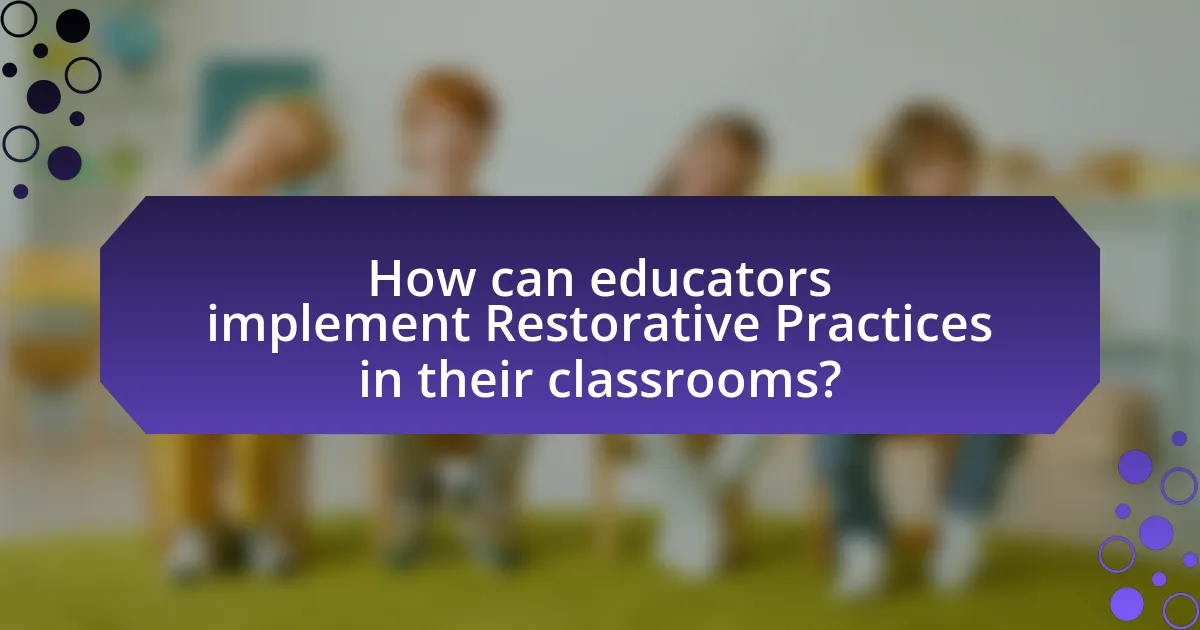
How can educators implement Restorative Practices in their classrooms?
Educators can implement Restorative Practices in their classrooms by fostering a community-oriented environment that emphasizes relationships and accountability. This can be achieved through regular circles for dialogue, where students share their feelings and experiences, promoting empathy and understanding. Research indicates that schools utilizing restorative practices see a reduction in disciplinary issues and an increase in student engagement, as evidenced by a study from the University of California, which found that restorative approaches led to a 50% decrease in suspensions. Additionally, educators should provide training on conflict resolution techniques, enabling students to resolve disputes collaboratively, thereby reinforcing a culture of respect and responsibility.
What steps should teachers take to introduce Restorative Practices?
Teachers should take the following steps to introduce Restorative Practices: first, they must educate themselves on the principles and philosophy of Restorative Practices, which focus on building relationships and community. Next, teachers should create a safe and inclusive classroom environment where students feel comfortable expressing their feelings and experiences. This can be achieved by establishing clear expectations for behavior and promoting open communication.
Following this, teachers should implement restorative circles, which provide a structured format for students to share their thoughts and resolve conflicts collaboratively. Additionally, teachers should involve students in the development of classroom rules and consequences, fostering a sense of ownership and accountability. Finally, ongoing training and support for teachers are essential to ensure the effective application of Restorative Practices, as research indicates that consistent implementation leads to improved student behavior and a positive classroom climate.
How can teachers create a Restorative classroom culture?
Teachers can create a restorative classroom culture by fostering open communication, building relationships, and implementing restorative practices that emphasize accountability and community. Establishing a safe environment where students feel valued encourages them to express their feelings and resolve conflicts collaboratively. Research indicates that classrooms utilizing restorative practices see a reduction in behavioral issues and an increase in student engagement, as highlighted in the study by Morrison and Vaandering (2012) in the “International Journal of Educational Management.” This approach not only addresses misbehavior but also promotes a sense of belonging and responsibility among students, reinforcing positive behavior and community ties.
What training or resources are available for educators?
Educators can access various training programs and resources focused on implementing restorative practices in classroom management. Notable resources include the International Institute for Restorative Practices (IIRP), which offers workshops, online courses, and certification programs specifically designed for educators. Additionally, the Restorative Justice in Education (RJE) initiative provides comprehensive training materials and guides that help educators integrate restorative practices into their teaching methods. Research indicates that schools implementing these practices report improved student behavior and a more positive school climate, reinforcing the effectiveness of these training programs.
How can teachers involve students in Restorative Practices?
Teachers can involve students in Restorative Practices by facilitating open dialogues that encourage students to express their feelings and perspectives regarding conflicts. This approach fosters a sense of ownership and accountability among students, as they actively participate in discussions about the impact of their actions on others. Research indicates that when students are engaged in restorative circles, they develop empathy and conflict resolution skills, leading to a more positive classroom environment. For instance, a study by Morrison and Vaandering (2012) highlights that student involvement in restorative practices significantly reduces behavioral issues and enhances community within the classroom.
What role do students play in the Restorative process?
Students play a crucial role in the Restorative process by actively participating in dialogue and reflection to address harm and restore relationships. Their involvement includes sharing their perspectives, taking responsibility for their actions, and contributing to the development of solutions that promote healing and accountability. Research indicates that when students engage in restorative practices, such as restorative circles, they enhance their understanding of the impact of their behavior, which fosters a sense of community and belonging within the classroom. This active participation not only empowers students but also leads to a reduction in disciplinary issues and an increase in positive school climate.
How can peer mediation be integrated into Restorative Practices?
Peer mediation can be integrated into Restorative Practices by training students to facilitate conflict resolution among their peers, thereby promoting accountability and understanding. This integration allows students to take an active role in resolving disputes, which aligns with the principles of Restorative Practices that emphasize repairing harm and restoring relationships. Research indicates that peer mediation programs can reduce conflict and improve school climate, as evidenced by a study conducted by the University of Colorado, which found that schools implementing peer mediation saw a 30% decrease in disciplinary incidents.
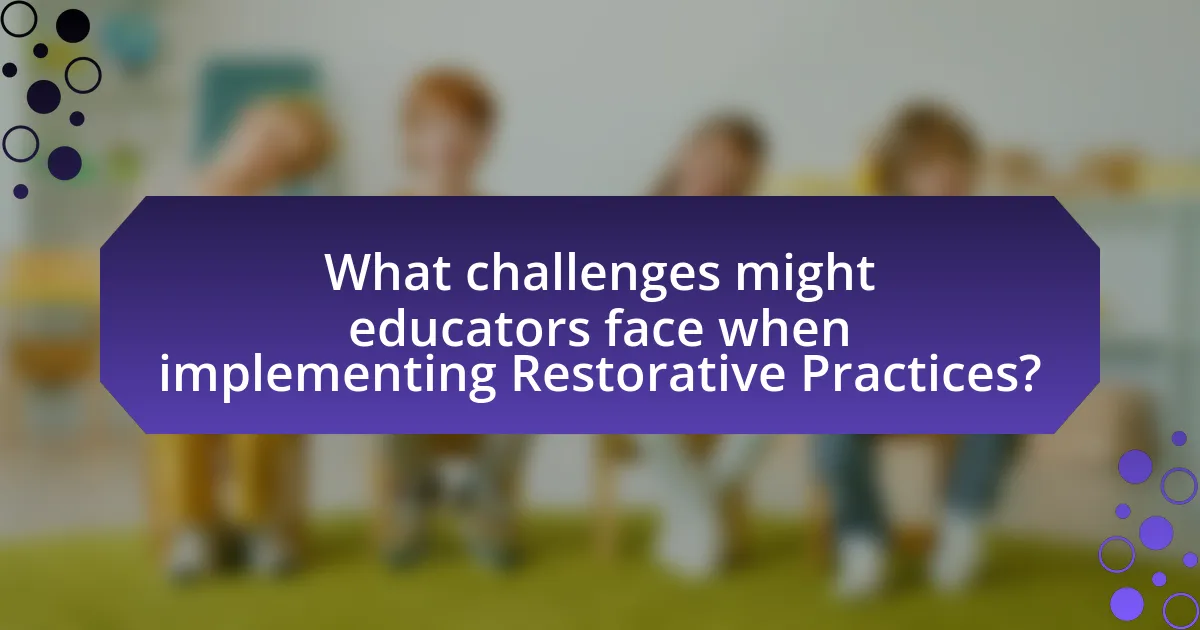
What challenges might educators face when implementing Restorative Practices?
Educators may face several challenges when implementing Restorative Practices, including resistance from students, lack of training, and insufficient administrative support. Resistance from students can stem from a preference for traditional disciplinary methods, which may lead to reluctance in engaging with restorative processes. Lack of training can hinder educators’ ability to effectively facilitate restorative conversations and interventions, as they may not be equipped with the necessary skills or knowledge. Additionally, insufficient administrative support can limit the resources and time allocated for implementing these practices, making it difficult for educators to integrate them into their classroom management strategies. These challenges can significantly impact the successful adoption of Restorative Practices in educational settings.
How can resistance from students or staff be addressed?
Resistance from students or staff can be addressed by fostering open communication and involving them in the decision-making process. Engaging students and staff in discussions about restorative practices allows them to express their concerns and suggestions, which can lead to greater buy-in and acceptance. Research indicates that when individuals feel heard and valued, their resistance diminishes; for example, a study by the National Education Association found that collaborative approaches in educational settings significantly improve stakeholder engagement and reduce opposition to new initiatives.
What strategies can be used to overcome common obstacles?
To overcome common obstacles in implementing restorative practices in classroom management, educators can utilize strategies such as building strong relationships, providing training, and fostering a supportive environment. Building strong relationships between teachers and students enhances trust, which is essential for effective restorative practices. Research indicates that positive teacher-student relationships lead to improved student behavior and engagement (Hamre & Pianta, 2001). Providing training for educators equips them with the necessary skills and knowledge to facilitate restorative practices effectively, addressing potential challenges in implementation. Additionally, fostering a supportive environment that encourages open communication and collaboration among staff, students, and parents can mitigate resistance and promote a culture of accountability and empathy. These strategies collectively address the common obstacles faced in the adoption of restorative practices in educational settings.
How can educators measure the effectiveness of Restorative Practices?
Educators can measure the effectiveness of Restorative Practices by analyzing changes in student behavior, academic performance, and school climate. Specifically, they can utilize quantitative data such as suspension and expulsion rates, which often decrease when restorative approaches are implemented. For instance, a study by the University of California, Los Angeles, found that schools employing restorative practices saw a 50% reduction in suspensions over a three-year period. Additionally, qualitative assessments through surveys and interviews can provide insights into students’ perceptions of safety and belonging, further indicating the impact of these practices.
What are some best practices for sustaining Restorative Practices in the long term?
To sustain Restorative Practices in the long term, it is essential to establish a strong foundation through ongoing training and support for educators. Continuous professional development ensures that teachers are equipped with the necessary skills and knowledge to effectively implement these practices. Research indicates that schools with regular training sessions see a 30% increase in the successful application of Restorative Practices over time. Additionally, fostering a school-wide culture that prioritizes relationships and community involvement reinforces the principles of Restorative Practices. Engaging families and community members in the process enhances accountability and support, leading to a more sustainable implementation. Regular evaluation and feedback mechanisms also play a critical role; schools that assess their Restorative Practices annually report improved outcomes in student behavior and school climate.
How can ongoing training and support be provided to staff?
Ongoing training and support for staff can be provided through regular professional development workshops, mentorship programs, and access to online resources. Professional development workshops can focus on restorative practices, equipping staff with the necessary skills and knowledge to implement these strategies effectively. Mentorship programs pair experienced staff with those new to restorative practices, fostering a supportive learning environment. Additionally, online resources such as webinars, articles, and forums can offer continuous learning opportunities, allowing staff to stay updated on best practices and share experiences with peers. Research indicates that schools implementing structured professional development see improved staff confidence and student outcomes, reinforcing the importance of ongoing training and support.
What role does community involvement play in sustaining Restorative Practices?
Community involvement is crucial for sustaining Restorative Practices as it fosters a supportive environment that encourages accountability and healing. When community members actively participate, they contribute to a shared understanding of values and norms, which reinforces the principles of Restorative Practices. Research indicates that schools with strong community ties report higher levels of student engagement and lower rates of conflict, demonstrating that community support enhances the effectiveness of restorative approaches. For instance, a study by the National Center for School Engagement found that schools implementing community-based restorative initiatives saw a 20% decrease in disciplinary incidents, highlighting the positive impact of community involvement on sustaining these practices.
What practical tips can educators use to successfully implement Restorative Practices?
Educators can successfully implement Restorative Practices by fostering a culture of open communication and building strong relationships with students. Establishing regular circles for dialogue encourages students to express their feelings and perspectives, which enhances understanding and empathy among peers. Additionally, training staff in conflict resolution techniques equips them to facilitate restorative conversations effectively. Research indicates that schools employing restorative practices see a reduction in disciplinary incidents and improved student engagement, as evidenced by a study from the International Institute for Restorative Practices, which found that 80% of schools reported positive changes in school climate after implementation.
How can teachers effectively communicate the goals of Restorative Practices to students and parents?
Teachers can effectively communicate the goals of Restorative Practices to students and parents by utilizing clear, consistent messaging and engaging in open dialogue. This involves explaining the principles of Restorative Practices, such as accountability, empathy, and community building, in simple terms that resonate with both students and parents. Research indicates that when educators provide specific examples of how Restorative Practices foster a positive school environment, it enhances understanding and buy-in from families. For instance, sharing success stories or data demonstrating improved student behavior and relationships can reinforce the benefits of these practices. Additionally, hosting workshops or informational sessions allows for direct interaction, enabling parents and students to ask questions and express concerns, thereby fostering a collaborative approach to implementing Restorative Practices in the classroom.
What are some examples of successful Restorative Practices in action?
Successful Restorative Practices in action include peer mediation programs, restorative circles, and community service initiatives. Peer mediation programs, such as those implemented in various schools, empower students to resolve conflicts with the guidance of trained peers, leading to a reduction in disciplinary incidents. Restorative circles, used in classrooms, foster open dialogue among students and teachers, promoting understanding and accountability, which has been shown to improve classroom climate and student relationships. Community service initiatives, like those adopted by some educational institutions, encourage students to take responsibility for their actions by engaging in service projects that benefit their community, reinforcing the connection between behavior and its impact on others. These practices have been documented to enhance student engagement and reduce recidivism in behavioral issues, demonstrating their effectiveness in educational settings.

